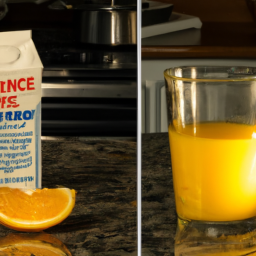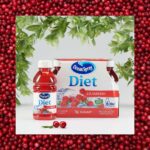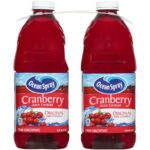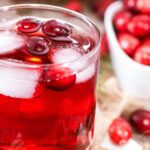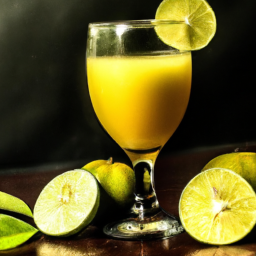As a frequent consumer of pure cranberry juice for its health benefits, I often question its refrigeration longevity. The lifespan of pure cranberry juice in the fridge is influenced by variables such as processing, storage, and ingredient quality. This article will explore these factors and address the query: what is the refrigerated shelf life of pure cranberry juice?
When it comes to pure cranberry juice, there are two main types: freshly squeezed and unpasteurized juice, and commercially processed juice. Freshly squeezed and unpasteurized juice is made by pressing fresh cranberries and is not heat-treated, while commercially processed juice is pasteurized to extend its shelf life.
Understanding the differences between these two types of juice is crucial in determining their shelf life. In the following sections, I will delve deeper into these factors that affect the shelf life of pure cranberry juice.
Key Takeaways
- Proper storage techniques are crucial for maintaining the freshness and quality of pure cranberry juice.
- Exposure to air and light can cause the juice to lose color, flavor, and become rancid, while oxidation prevention is important for extending its shelf life.
- Pure cranberry juice can last up to two weeks in the fridge if properly stored, but commercially processed juice has a longer shelf life due to added preservatives that can detract from its natural flavor and nutritional value.
- Health risks of drinking spoiled cranberry juice include food poisoning, bacterial infections, and digestive issues, making it important to refrigerate pure cranberry juice immediately after opening and consume it within 7-10 days.
Factors Affecting the Shelf Life of Pure Cranberry Juice
The shelf life of pure cranberry juice can be affected by factors such as temperature, light exposure, and air exposure. Proper storage is crucial in maintaining the freshness of the juice. It’s best to keep the juice in an airtight container, such as a glass bottle, and store it in the refrigerator at a temperature of 40°F or below. This will slow down the growth of bacteria and prevent spoilage.
Oxidation prevention is another important factor in extending the shelf life of pure cranberry juice. Exposure to air and light can cause the juice to lose its natural color and flavor and become rancid. It’s recommended to consume the juice within a week of opening and to keep it away from direct sunlight.
By following these guidelines, the juice can last up to two weeks in the refrigerator. Understanding freshly squeezed and unpasteurized juice is the next step in enjoying the full benefits of pure cranberry juice.
Understanding Freshly Squeezed and Unpasteurized Juice
As someone who’s interested in the quality and safety of my juice, I want to discuss the subtopic of freshly squeezed and unpasteurized juice.
It’s important to note that these types of juices have a shorter shelf life compared to their pasteurized counterparts.
Additionally, there are potential health risks associated with consuming unpasteurized juice, as it may contain harmful bacteria that can cause foodborne illnesses.
Shorter Shelf Life
Hey, did you know that cranberry juice doesn’t hang around for long in the fridge? It’s like a shooting star, here for a brief moment before fading away. One of the reasons for this shorter shelf life is because pure cranberry juice is typically unpasteurized, which means it hasn’t undergone the process of heating to kill off bacteria and extend its lifespan. As a result, proper storage is crucial to maintain its freshness and quality.
To help you better understand the shelf life of pure cranberry juice, here’s a table outlining some freshness indicators and storage tips:
| Freshness Indicator | Storage Tip |
|---|---|
| Color | Should be deep red and consistent |
| Smell | Should be tart and fruity |
| Taste | Should be sour with a hint of sweetness |
| Temperature | Store in the fridge at 40°F or lower |
| Time | Consume within 7-10 days of opening |
It’s important to note that consuming expired cranberry juice can lead to potential health risks, which we’ll explore in the next section.
Health Risks
Consuming expired cranberry juice can pose potential health risks, so it’s important to be mindful of its shelf life. Understanding acidity levels is crucial when it comes to ensuring the safety of cranberry juice.
Pure cranberry juice has a natural pH level of about 2.3 to 2.5, which is highly acidic. This acidity helps to preserve the juice for a limited amount of time, but it also means that it can cause gastrointestinal issues if consumed past its expiration date.
It’s also important to note that potential allergic reactions may occur if cranberry juice is consumed beyond its shelf life. As the juice breaks down, it can produce harmful bacteria and mold that can cause allergic reactions in some individuals.
This is why it’s recommended to consume cranberry juice within a few days of opening the bottle or within the expiration date on the package. Now, let’s move on to the next section and discuss commercially processed juice.
Commercially Processed Juice
As I delve into the topic of commercially processed juice, two key points come to mind: longer shelf life and added preservatives.
Commercially processed juice undergoes a series of treatments to extend its shelf life and remain safe for consumption. This includes the addition of preservatives to prevent bacterial growth and oxidation.
Longer Shelf Life
You’ll be happy to know that pure cranberry juice can last up to two weeks in the fridge if properly stored in an airtight container. When it comes to storage tips, the key is to keep the juice away from any sources of heat or light.
This means storing it in the back of the fridge, away from the door, and in a container that is opaque or has a dark tint. Additionally, be sure to avoid any cross-contamination by using a clean spoon or pouring the juice directly into a glass instead of drinking from the bottle.
Preserving freshness is also important for keeping pure cranberry juice from spoiling in the fridge. One way to do this is to make sure the juice is tightly sealed in its container to prevent any air from getting inside. You can also add a squeeze of lemon juice to help preserve the color and flavor of the cranberry juice.
By following these storage and freshness tips, you can make sure your pure cranberry juice lasts for up to two weeks in the fridge without losing its quality.
When it comes to added preservatives, some cranberry juice brands may include them to extend the shelf life even further. However, it’s important to check the label and make sure you’re comfortable with the ingredients before purchasing.
Added Preservatives
If you’re looking for a juice that lasts as fresh as a crisp fall morning, some brands of cranberry juice may have added preservatives to extend their shelf life. These preservatives can include chemicals such as sodium benzoate and potassium sorbate, which help prevent the growth of bacteria and mold.
While these additives can give the juice a longer lifespan, they may also detract from the natural flavor and nutritional value of the juice. For those who prefer preservative-free options, there are alternatives to extend shelf life.
One option is to freeze the juice in an airtight container, which can keep it fresh for up to six months. Another option is to add lemon juice, which can naturally preserve the cranberry juice for up to two weeks in the fridge.
Regardless of your chosen method, it’s important to store your juice properly to ensure it stays fresh and delicious.
Proper Storage Techniques
When it comes to proper storage techniques for pure cranberry juice, there are a few key points to keep in mind.
First, always make sure to seal the juice tightly after opening to prevent oxidation and contamination.
Second, store the juice in the fridge to maintain its freshness and extend its shelf life.
Lastly, be sure to control the temperature of the fridge, keeping it at a consistent temperature of 40°F or below to prevent spoilage.
By following these simple steps, you can ensure that your pure cranberry juice stays fresh and delicious for as long as possible.
Sealing the Juice
To keep your pure cranberry juice fresh in the fridge, make sure the container is tightly sealed. Sealing the juice provides a lot of benefits, such as preventing oxygen from entering the container, which can cause oxidation and spoilage.
Moreover, sealing the juice can also prevent any unwanted odors from entering the juice and affecting its taste. When it comes to choosing the best containers to use, it’s important to opt for airtight options. This can include glass bottles with screw-on lids or plastic containers with snap-on lids.
It’s also essential to check that the lids are securely fastened and that there are no cracks or leaks in the containers. By sealing your pure cranberry juice in an airtight container, you can ensure that it will stay fresh and delicious for a longer period of time.
To ensure that your pure cranberry juice stays fresh and tasty, it’s important to store it in the fridge at the right temperature.
Storing in the Fridge
In the previous subtopic, we talked about the importance of properly sealing pure cranberry juice to prolong its shelf life. Now, let’s move on to the next step, which is storing it in the fridge. By doing so, you can extend the juice’s freshness and reap its full health benefits.
To ensure that your pure cranberry juice lasts as long as possible, it’s essential to store it in the fridge. The cold temperature helps slow down the growth of bacteria, allowing the juice to maintain its freshness for a more extended period. You can keep the juice in the fridge for up to two weeks after opening it, as long as it’s in a tightly sealed container or bottle. Alternatively, you can use other storage methods to make the juice last even longer.
| Alternative Storage Methods | Benefits of Consuming Pure Cranberry Juice |
|---|---|
| Freezing | Can last up to six months. Great for making cranberry juice ice cubes. |
| Canning | Can store the juice for up to a year. Ideal for making large batches. |
| Vacuum Sealing | Can extend the juice’s shelf life up to three weeks. Great for traveling or camping. |
| Adding Sugar | Can help preserve the juice for up to a week. Not recommended for those watching their sugar intake. |
| Mixing with Other Juices | Can add variety to your diet while reaping cranberry juice’s health benefits. Great for those who find the juice too tart. |
Storing pure cranberry juice in the fridge is the best way to keep it fresh for up to two weeks. However, if you want to extend its shelf life, you can use alternative storage methods like freezing, canning, or vacuum sealing. Regardless of how you store it, drinking pure cranberry juice regularly provides a host of health benefits, including improved urinary tract health and decreased risk of chronic diseases. Moving forward, let’s discuss the importance of temperature control in the next section.
Temperature Control
Maintaining proper temperature control is crucial if you want to enjoy the full health benefits of your favorite cranberry juice. Have you ever tried drinking warm, spoiled juice? Not only does it taste terrible, but it can also lead to gastrointestinal issues and other health problems.
To avoid spoilage, it’s essential to understand the proper temperature and storing techniques for pure cranberry juice in the fridge. Firstly, make sure to store your cranberry juice at a temperature below 40°F (4°C) to prevent bacterial growth and maintain freshness. Keep the juice in the back of the fridge, where the temperature is the most consistent, and make sure it’s tightly sealed. Avoid storing cranberry juice in the door, as the temperature fluctuates frequently when opening and closing the refrigerator.
By following these proper temperature and storing techniques, you can ensure that your cranberry juice remains fresh and delicious, with all of its health benefits intact. If you’ve stored your pure cranberry juice properly, you may be wondering how long it will last in the fridge. The answer to this question depends on several factors, such as the expiration date, the quality of the juice, and the storage conditions.
In the next section, we’ll explore how long pure cranberry juice lasts in the fridge and some signs to look out for when it goes bad.
How Long Does Pure Cranberry Juice Last in the Fridge?
I’ve been wondering how long pure cranberry juice lasts in the fridge.
From my research, I found out that it can last up to two weeks if properly stored.
However, the shelf life of cranberry juice can be affected by factors such as temperature, exposure to light, and the quality of the product.
Up to Two Weeks
You can enjoy your pure cranberry juice for up to two weeks in the fridge! Proper storage is key to extending the shelf life of your cranberry juice. It’s important to keep it refrigerated at all times and avoid leaving it out at room temperature for too long. A cool and dry place is also ideal for storage.
Aside from its delicious taste, cranberry juice also has numerous benefits for our health. It’s rich in antioxidants and has been shown to improve urinary tract health, prevent infections, and even promote heart health.
With such great benefits, it’s no wonder that many people choose to enjoy a glass of pure cranberry juice daily. However, it’s important to note that factors such as the quality of the juice, packaging, and storage conditions can affect its shelf life.
Factors that Affect Shelf Life
Keeping your cranberry juice in a dark and cool place, like a pantry, can help it stay fresh for a longer period of time. However, proper storage is not the only factor that affects its shelf life. Here are some other things to keep in mind to ensure that your pure cranberry juice stays fresh and delicious:
-
Exposure to air: Once the container is opened, the juice is exposed to air, which can cause it to spoil faster. Make sure to seal the container tightly after each use.
-
Temperature fluctuations: Fluctuations in temperature can also affect the quality and shelf life of the cranberry juice. It’s best to store it in a consistently cool temperature.
-
Shelf life: Pure cranberry juice can last up to two weeks in the fridge, but this can vary depending on the brand and the storage conditions.
Knowing these factors can help you extend the shelf life of your cranberry juice and enjoy its freshness for a longer time. But if you notice changes in its taste, texture, or appearance, it may be time to check if it has gone bad.
Signs that Pure Cranberry Juice has Gone Bad
I want to talk about the signs that pure cranberry juice has gone bad. It’s important to be aware of these signs to avoid consuming spoiled juice.
The three key indicators of spoilage are discoloration, foul smell, and strange taste.
Discoloration
Hey there, did you know that if you see any discoloration in your pure cranberry juice, it’s a sign that it’s time to toss it out? Discoloration can occur due to several reasons, such as exposure to air, sunlight, or high temperatures. However, it can also be prevented by following some simple steps.
Here are three emotional reasons why you should take care of your pure cranberry juice to prevent discoloration:
-
You don’t want to compromise the benefits of pure cranberry juice for your skin. Cranberry juice is packed with antioxidants, which help fight free radicals and prevent premature aging. However, discoloration can be an indication that the juice has lost some of its nutritional value, making it less effective for your skin.
-
You don’t want to waste your money on a product that has gone bad. Pure cranberry juice can be expensive, and if it’s not stored properly, it can spoil quickly. By taking measures to prevent discoloration, you can ensure that you get the most out of your investment. Proper storage, such as keeping the juice refrigerated and tightly sealed, can significantly extend its shelf life and preserve its nutritional value. To make informed purchasing decisions, consider consulting a cranberry juice pricing guide, which will help you compare prices and find the best deals without compromising quality. This way, you’ll protect both your wallet and your health by choosing products that offer the best value.
-
You don’t want to risk your health by consuming spoiled juice. Discoloration can be a sign that the juice has been contaminated with bacteria, which can cause food poisoning. It’s always better to err on the side of caution and discard any juice that doesn’t look right.
Now that you know how important it is to prevent discoloration in your pure cranberry juice, let’s move on to another sign that it’s time to throw it out: foul smell.
Foul Smell
If your nose wrinkles up at the scent of your cranberry juice, it’s time to say goodbye to that stinky bottle. Foul smell is a common indication that your cranberry juice has gone bad. This can happen if the juice has been stored in the fridge for too long or if it has been exposed to air.
You can prevent this from happening by storing your cranberry juice properly. Keep it in an airtight container and make sure the lid is tightly sealed. This will prevent air from getting in and causing the juice to spoil.
If you do find yourself with a bottle of cranberry juice that has gone bad, don’t worry. You don’t have to throw it away just yet. There are many recipes that you can use foul cranberry juice in, such as sauces, marinades, and even cocktails. Just make sure to taste the juice before using it in a recipe. If the flavor is too strong or unpleasant, it’s best to discard it.
In the next section, we’ll discuss another indicator that your cranberry juice may have gone bad: strange taste.
Strange Taste
When you taste your cranberry juice and it doesn’t quite hit the spot, it could be a sign that it has gone bad. One of the most common indicators of spoiled cranberry juice is an unusual flavor that is distinctly different from the tart and tangy taste that is characteristic of fresh juice.
If your cranberry juice has a strange taste, it could be due to a variety of factors such as exposure to air, improper storage, or the growth of bacteria. It’s important to note that consuming spoiled cranberry juice can have negative effects on your health, despite the many benefits that this juice has to offer.
Some potential health risks associated with drinking spoiled cranberry juice include food poisoning, bacterial infections, and digestive issues. Therefore, it’s crucial to inspect your cranberry juice before drinking it and discard any that have an unusual flavor or smell.
Health Risks of Spoiled Juice
The potential health risks of drinking spoiled cranberry juice include food poisoning and gastrointestinal discomfort. It’s important to take necessary precautions when handling and storing cranberry juice to prevent contamination. Always make sure to wash your hands thoroughly before handling the juice and use clean utensils and containers.
Identifying spoilage of pure cranberry juice can be challenging as it doesn’t always have a clear expiration date. Signs of spoilage can include a strange odor, mold growth, and a change in color or texture. To prevent consuming spoiled juice, it’s recommended to refrigerate pure cranberry juice immediately after opening and consume it within 7-10 days.
To extend the shelf life of pure cranberry juice, it’s important to store it properly. Keep the juice in a cool, dry place away from direct sunlight and heat sources. You can also freeze cranberry juice in ice cube trays and use them in smoothies or as a refreshing addition to water.
By taking the necessary precautions and storing the juice properly, you can ensure a longer shelf life and avoid the potential health risks associated with consuming spoiled juice.
Tips for Extending the Shelf Life of Pure Cranberry Juice
To maximize its freshness, store your cranberry juice in a cool, dry place away from heat and sunlight, and freeze it in ice cube trays for a refreshing addition to your beverages. Additionally, here are some tips that can help you extend the shelf life of your pure cranberry juice:
| Tips for Extending the Shelf Life of Pure Cranberry Juice | ||
|---|---|---|
| 1. Keep the juice refrigerated | 2. Store the juice in an airtight container | 3. Consume the juice within 7-10 days of opening |
By following these simple tips, you can ensure that your pure cranberry juice stays fresh for longer and retains its nutritional value. And if you do end up with some leftover juice, don’t fret! There are plenty of creative ways to use it, from adding it to smoothies and cocktails to incorporating it into sauces and dressings. So go ahead and stock up on your favorite brand of pure cranberry juice, knowing that you can make the most of it.
Creative Ways to Use Leftover Cranberry Juice
Looking for ways to get creative with your leftover cranberry juice? Try adding it to your favorite baking recipes for a tart and flavorful twist. Cranberry juice can be used as a substitute for other liquids in recipes such as muffins, cakes, and even pancakes.
The juice can also be used to make a glaze for meats such as pork or chicken, giving it a tangy and sweet flavor. Another creative recipe idea for leftover cranberry juice is to make a cranberry vinaigrette for your salads. Simply mix the juice with olive oil, vinegar, honey, and some chopped herbs for a refreshing dressing.
The juice can also be used to make cranberry popsicles or as a base for a fruity cocktail. When storing leftover cranberry juice, make sure to keep it in an airtight container in the refrigerator for up to 10 days. You can also freeze it in ice cube trays and use it later for smoothies or other recipes.
Frequently Asked Questions
Can pure cranberry juice be frozen for longer storage?
When it comes to freezing cranberry juice for longer storage, it’s important to keep in mind that liquids expand when frozen. To avoid any potential mess, leave some room in the container before freezing. When thawing cranberry juice, do so in the fridge to ensure safety and quality.
What are some common recipes that use pure cranberry juice?
I enjoy using pure cranberry juice in various cranberry juice cocktails and as a marinade for meats. It adds a tart and tangy flavor that complements well with other ingredients.
Is it safe to consume pure cranberry juice past its expiration date?
Consuming expired cranberry juice can lead to bacterial growth and potential food poisoning. The health effects vary depending on the severity of the contamination. Always check the expiration date before consuming any juice.
Can the taste of pure cranberry juice change over time?
Over time, pure cranberry juice may experience flavor deterioration and nutritional changes. These changes can occur regardless of how long the juice has been stored in the fridge.
How does the shelf life of homemade pure cranberry juice compare to store-bought options?
When comparing homemade pure cranberry juice to store-bought options, the shelf life can vary. Homemade juice lacks preservatives and should be consumed within a few days for optimal freshness, while store-bought options can last longer due to added preservatives.
Conclusion
To sum it up, the shelf life of pure cranberry juice depends on various factors, including the type of juice, processing, storage, and expiration date. Freshly squeezed and unpasteurized juice has a shorter lifespan compared to commercially processed juice.
Proper storage techniques can help extend the shelf life of cranberry juice, but it’s essential to check for signs of spoilage before consuming it. In the end, it’s crucial to remember that consuming spoiled juice can pose health risks, so it’s best to err on the side of caution. As the saying goes, "better safe than sorry."
So, if you’re unsure about the freshness of your cranberry juice, it’s better to discard it and get a fresh batch. With these tips in mind, you can ensure that your cranberry juice stays fresh and delicious for longer.
Cindy thoroughly researches juicing trends, techniques, and recipes to provide readers with practical advice and inspiration. Her writing style is accessible, engaging, and designed to make complex concepts easy to understand. Cindy’s dedication to promoting the advantages of juicing shines through her work, empowering readers to make positive changes in their lives through the simple act of juicing.


